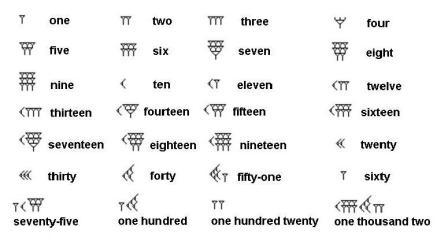
In the book How Mathematics Happened: The First 50,000 Years, Peter Rudman argues that the development of the concept of prime numbers could only have come about after the concept of division, which he dates to after 10,000 BC, with prime numbers probably not being understood until about 500 BC. Common interpretations are that the Ishango bone shows either the earliest known demonstration of sequences of prime numbers or a six-month lunar calendar.
#Babylonian numerals to decimal notation ca series#
The Ishango bone consists of a series of tally marks carved in three columns running the length of the bone. One common interpretation is that the bone is the earliest known demonstration of sequences of prime numbers and of Ancient Egyptian multiplication. The Ishango bone, found near the headwaters of the Nile river (northeastern Congo), may be as much as 20,000 years old. The Ishango bone, dating back to perhaps 18,000 to 20,000 BCĪlso prehistoric artifacts discovered in Africa, dated between 35,000 and 20,000 years old, suggest early attempts to quantify time. Also, prehistoric artifacts discovered in Africa, dated between 35,000 and 20,000 years old, suggest early attempts to quantify time. It consists of 29 distinct notches cut into a baboon's fibula. The oldest known possibly mathematical object is the Lebombo bone, discovered in the Lebombo mountains of Swaziland and dated to approximately 35,000 BC. Moreover, hunters and herders employed the concepts of one, two, and many, as well as the idea of none or zero, when considering herds of animals. There is evidence that women devised counting to keep track of their menstrual cycles 28 to 30 scratches on bone or stone, followed by a distinctive marker. For example, paleontologists have discovered in a cave in South Africa, ochre rocks about 70,000 years old, adorned with scratched geometric patterns. Long before the earliest written records, there are drawings that indicate some knowledge of elementary mathematics and of time measurement based on the stars. The idea of the "number" concept evolving gradually over time is supported by the existence of languages which preserve the distinction between "one", "two", and "many", but not of numbers larger than two. Such concepts would have been part of everyday life in hunter-gatherer societies. Modern studies of animal cognition have shown that these concepts are not unique to humans.

The origins of mathematical thought lie in the concepts of number, magnitude, and form. See also: History of mathematical notation and History of science and technology in Africa 4.1.2 Kerala school of Indian mathematics.3.6 Kerala school of Indian mathematics (c.3.5 Renaissance European mathematics (c.3.3.2 Tang Dynasty to Song Dynasty (c.3.3.1 Southern and Northern Dynasties (c.3.1 Early Medieval European mathematics (c.2.2.1 Early Dynastic Period to Old Kingdom (c.2.1 Ancient Mesopotamian mathematics (c.Since the early modern period, mathematical developments, interacting with scientific discoveries, were made at an increasing pace, and this continues to the present day. Many Greek and Arabic texts on mathematics were eventually translated into Latin in medieval Europe and further developed there.Ī striking feature in the history of ancient and medieval mathematics is that bursts of mathematical development were sometimes followed by centuries of stagnation. In turn, Hellenistic and Indian mathematics were further developed and greatly expanded by Arabic and Islamic mathematicians, with Iraq/Mesopotamia as the center of Islamic learning. All of these texts concern the so-called Pythagorean theorem, one of the most ancient mathematical developments after basic arithmetic and geometry.Īncient Egyptian and Mesopotamian/Babylonian mathematics were further developed by Greek and Hellenistic mathematicians, with Egypt as the center of Hellenistic learning. 1650 BC), and the Shulba Sutras ( Indian mathematics ca. 1850 BC), the Rhind Mathematical Papyrus (Egyptian mathematics ca.

1900 BC), the Moscow Mathematical Papyrus ( Egyptian mathematics ca. The most ancient mathematical texts available are Plimpton 322 ( Babylonian mathematics ca.

The area of study known as the history of mathematics is primarily an investigation into the origin of discoveries in mathematics and, to a lesser extent, an investigation into the standard mathematical methods and notation of the past.īefore the modern age and the worldwide spread of knowledge, written examples of new mathematical developments have come to light only in a few locales.


 0 kommentar(er)
0 kommentar(er)
